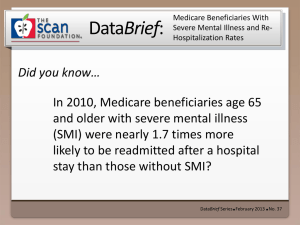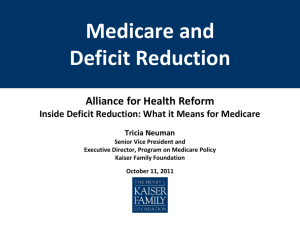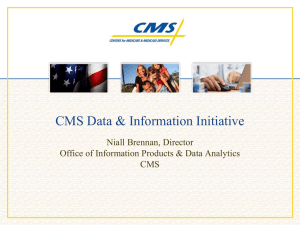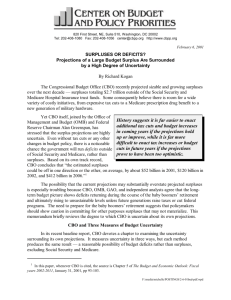The Future Of Social Security
advertisement
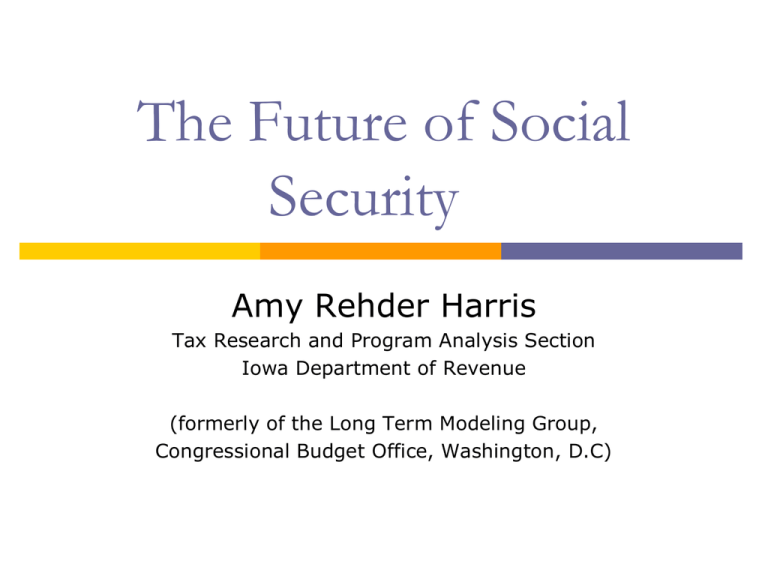
The Future of Social Security Amy Rehder Harris Tax Research and Program Analysis Section Iowa Department of Revenue (formerly of the Long Term Modeling Group, Congressional Budget Office, Washington, D.C) History of Social Security Social Security (OASDI) is mandatory public insurance to alleviate poverty in old-age Old-Age Insurance established 1935 Expanded to include Survivors and Spouses in 1939 Disability Insurance introduced 1956 Hospital Insurance (Medicare) began 1965 Old-Age Eligibility Must work at least 10 years While working, pay 6.2% (12.4%) payroll tax on earnings up to taxable maximum $106,800 in 2011 During 2011 – employee pays 2% less – TRA 2010 Upon retirement, benefits a function of AIME: highest 35 years of earnings (indexed for inflation) PIA: progressive formula – higher replacement for lower lifetime income NRA: rising from 65 to 67 for birth years 1960+ Age at claim (Claim at EEA of 62 = 30% reduction; Claim at 70 with DRC = 24% increase) Primary Insurance Amount $30,000 $30,000 15 percent replacement up to maximum Annual Benefit at NRA $25,000 $25,000 32 percent replacement through $54,204 $20,000 $20,000 $15,000 $15,000 $10,000 $10,000 $5,000 $5,000 90 percent replacement up to $8,988 $0 $0 $0 $12,000 $24,000 $36,000 $48,000 $60,000 Average Annual Earnings $72,000 $84,000 Old-Age Benefits Retired Workers 32.3 million beneficiaries in Dec. 2008 Average annual benefit was $13,800 in 2008 Auxiliary Beneficiaries Spouses: 2.4 million Survivors: 4.4 million Children: 2.4 million Also mother/father or parents Spouse Benefits Established in era of one-earner household Married to a worker at retirement Married for 10 years or more if divorced Receive benefit equal to 50 percent of PIA Reduced based on claim age of spouse Average annual benefit was $6,800 in 2008 For two-earner household, spouse with lower earnings could receive no additional benefit even though paid tax of 12.4% on every dollar earned Survivor Benefits Established in era of one-earner household Married to a worker at death Married to deceased worker for 10 years or more if divorced Receive benefit equal to 100 percent of worker benefit Reduced based on claim age of survivor Average annual benefit was $13,300 in 2008 Survivor in retired household faces up to 1/3 benefit reduction at death of spouse Annual Cost-of-Living Adjustment 1973 a COLA created to account for impact of inflation on current beneficiaries Prior to then, required act of Congress COLA is linked to consumer price index Flat (and falling) prices from late 2008 through 2010 lead to two years of no cost-of-living increases Cry for “relief” $250 checks sent out in 2009 ($13 B) Nothing equivalent for 2010 or 2011 planned Disability Insurance Eligible if worked 5 of previous 10 years Benefit is function of earnings divided by years worked prior to disability (minus lowest 5 years) 7.4 million beneficiaries in 2008 with average annual benefit of $12,800 Auxiliary beneficiaries: 1.8 million Large growth in beneficiaries Recent expansion to mental illness and back pain Concerns about incentives to claim DI rather than OAI when nearing EEA (no benefit reduction) Spike in claims during current recession among unemployed Iowa’s Aging Population 24% 24% 22% 22% 20% 20% 18% 18% Iowa Share 65+ 16% 16% 14% 14% 12% 12% US Share 65+ 10% 10% Iowa Share 75+ 8% 8% 6% 6% US Share 75+ 4% 4% Iowa Share 85+ 2% 2% US Share 85+ 0% 0% 2000 2005 2010 2015 2020 2025 2030 Population Pyramid or Tower? Figure 2. Iowa Population Pyramid Projections, 2010 and 2030 Percent of Total Population 2010 2030 Male 5 4 85+ 80 - 84 75 - 79 70 - 74 65 - 69 60 - 64 55 - 59 50 - 54 45 - 49 40 - 44 35 - 39 30 - 34 25 - 29 20 - 24 15 - 19 10 - 14 5-9 0-4 Female 3 2 1 0 1 2 3 4 5 Female Male 5 4 3 2 1 0 1 2 3 4 5 Impact of Aging Population Worker-Beneficiary Ratio Iowa and US: 3.0 falling to 2.0 Manifested through deteriorating tax bases OASDI: Wages Income Taxes: Pensions and investment earnings often receive preferential tax treatment, additional exempt earnings by age Taxation of Social Security “Contributions” taxed as income when earned by federal and state governments Benefits paid at retirement non-taxable until 1983 If other income above $32,000/$25,000, up to 50% taxable Revenue to OASDI Trust Fund Attempting to improve system finances in preparation for baby boomers 1993 up to 85%, money to Medicare Taxation of Social Security in Iowa Followed federal rules by taxing 50% of benefits for seniors with other income Fear that encouraging high-income elderly to move out of state at retirement 2006 change – phase-out of taxation on benefits by 2014 (67% of taxable benefits exempt in 2011) Evidence suggests elderly move to warmer climates, not non-tax states Social Security Long Run Finances Social Security currently running surpluses – saved in OASDI Trust Fund Taxes > Benefits Projections show future will have large deficits How are those projections made? What can Congress do to prevent the system from going broke? CBO Projected Outlays and Revenues 1985-2084 10 10 9 9 Share of GDP 8 8 Outlays 7 7 6 6 5 5 4 4 3 3 Revenues 2 2 1 1 0 1985 0 1995 2005 2015 2025 2035 2045 2055 2065 2075 Impact of the Great Recession - Revenues Minus Outlays Social Security Administration Social Security is administered by SSA, an executive branch agency SSA produces an Annual Trustees report about the future of the system Short-run (10 years) Long-run (75 years) http://www.ssa.gov/OACT/TR/2010/tr2010.pdf CBO produces long-term projections http://www.cbo.gov/ftpdocs/119xx/doc11 943/10-22-SocialSecurity_chartbook.pdf Long-Run Projections Taxest = Tax Ratet * Average Waget * Number Workerst Benefitst = Average Benefitt * Number Beneficiariest Trust Fundt = Trust Fundt-1 + Interestt + Taxest – Benefitst Projecting Taxes Taxest = Tax Ratet * Average Waget * Number Workerst Average Wage depends on productivity (real wage growth), inflation, and wages as a share of compensation (growth of cash versus benefits) Projecting Taxes Taxest = Tax Ratet * Average Waget * Number Workerst Average Wage depends on productivity (real wage growth), inflation, and wages as a share of compensation (growth of cash versus benefits) Number Workers depends on fertility, immigration and unemployment Projecting Benefits Benefitst = Average Benefitt * Number Beneficiariest Average Benefit depends on past wages and inflation (along with all of the policy rules) Projecting Benefits Benefitst = Average Benefitt * Number Beneficiariest Average Benefit depends on past wages and inflation (along with all of the policy rules) Number Beneficiaries depends on fertility (60 years earlier), mortality, and disability rates Projecting Trust Fund Balances Trust Fundt = Trust Fundt-1 + Interestt + Taxest – Benefitst Interest rates on government bonds (IOU’s to ourselves) Ten Key Assumptions Five Economics Assumptions: Future earnings (1) (2) (3) (4) Real wage growth Inflation Unemployment Wage as a Share of Compensation Future benefits paid to retirees, the disabled, spouses and survivors Earnings on the existing Trust Fund (5) Interest rate Ten Key Assumptions (cont) Five Demographics Assumptions: How many people will be paying taxes and receiving benefits (6) Mortality (7) Fertility (8) Immigration (9 & 10) Disability Incidence and Termination 2009 changes to mortality assumptions worsened finances 2010 changes to mortality data improved finances SSA Projections Intermediate assumptions Uncertainty about 75 years into the future - Range on assumptions “Best guess” Low-cost High-cost Problems with scenario analysis Unlikely No measured probability of actually happening CBO Projections Stochastic projections (500 runs) Median Uncertainty about 75 years into the future - Range on outcomes 90th percentile 10th percentile Actuarial Balance 75-Year Actuarial Balance Present value of taxes minus present value of benefits over present value of payroll The size of the tax increase needed today to fund the system for the next 75 years SSA projects -1.92 (from -2.00 last year) Legislative changes raising wages as a share of compensation (Affordable Care Act) More optimistic current data on death rates CBO projects range -3.2 to -0.5 Income and Cost Rates Income Rate/Revenues Payroll taxes as percent of GDP 2009: 4.9 2084: 4.8-5.2 Cost Rate/Outlays Benefits as percent of GDP 2009: 4.8 2084: 5.1-8.8 CBO Projected Outlays and Revenues 1985-2084 10 10 9 9 Share of GDP 8 8 Outlays 7 7 6 6 5 5 4 4 3 3 Revenues 2 2 1 1 0 1985 0 1995 2005 2015 2025 2035 2045 2055 2065 2075 Trust Fund Ratio Trust fund assets over annual expenditures Measures if the system can pay benefits Currently large surplus Source of touted “Exhaustion Date” SSA projects the system will “go broke” in 2037 (same as last year) CBO projects between 2032 to 2058 However, current outlays exceed revenues – living on interest and soon trust fund assets will be “redeemed” CBO Projected Trust Fund Ratio, 1985-2084 Ratio of Trust Fund Balance to Annual Outlays 10 10 5 5 0 0 -5 -5 -10 -10 -15 -15 -20 -20 -25 1985 -25 1995 2005 2015 2025 2035 2045 2055 2065 2075 Hope under Current Law? Taxest = Tax Ratet * Average Waget * Number Workerst Benefitst = Average Benefitt * Number Beneficiariest Trust Fundt = Trust Fundt-1 + Interestt + Taxest – Benefitst Hope with Changes to Current Law? Taxest = Tax Ratet * Average Waget * Number Workerst Benefitst = Average Benefitt * Number Beneficiariest Trust Fundt = Trust Fundt-1 + Interestt + Taxest – Benefitst Changes to Current Law? Increase taxes above current 6.2% Regressive tax Raise taxable maximum with no benefit increase? Risk of doing nothing – required tax increases (1.9 percentage points today, to 14.3 percent, good for next 75 years ONLY) Future workers pay (much higher if wait longer) Changes to Current Law? Increase taxes above current 6.2% Reduce benefits paid to current or future beneficiaries Raise NRA further? Risk of doing nothing – about 2040 when system no longer takes in enough resources not all of promised benefits can be paid Across-the-board benefit cuts? (estimated 22 percent cut in benefits for all) Future beneficiaries pay (much higher if only new beneficiaries affected) Changes to Current Law? Increase taxes above current 6.2% Reduce benefits paid to current or future beneficiaries Raise the interest earned by the Trust Funds through investing in more risky assets, either the government or individual workers Current credit market problems make most wary Risks of Government Investing Bad stock returns could harm new retirees (35% of the time – lose money) Only 5% chance better off in all years over next 75 Public control over private assets creates conflicts “Social Investing” Individual Accounts Allow individuals to take part of payroll tax and invest in higher returns paid by the stock market Trade-off is must accept higher risks Stock market is NOT a sure thing President Obama Opposes any “privatization” Proposed no specific changes in FY 2012 budget, but some reportedly considered: Raising taxable maximum to $180,000 from current $106,800 (90% of wages, up from 84%) Change COLA calculation, reduce growth of benefits Bring uncovered state and local employees into the system (small numbers) National Commission on Fiscal Responsibility and Reform Make PIA formula more progressive Raise taxable maximum to 90% of wages Make COLA calculation more accurate Raise NRA (69) and EEA (64) by 2075 Cover all state and local employees Low-earner benefit at 125% of poverty Raise benefits for very old and long-time disabled (over 20 years) Improve education of future retirees Increase flexibility for claiming benefits Encourage personal retirement savings Your future retirement? Social Security benefits are uncertain for your generation if reforms not instituted soon Still not a great method of “saving” for retirement Three-legged stool Public pension (Social Security) Private pension (401k) Personal saving (Roth IRA) Economics informs us - solution is political Even Bigger Mess: Medicare Congressional efforts for Social Security reform ended with 2006 election Current health care reform debate has shifted focus to Medicare Much bigger financial problem Same concerns about aging with little control on benefit costs Serves as an example of government-run health care Considered in Affordable Care Act – mostly as a source of funds Medicare defined Medicare is publicly-provided health insurance for the elderly Medicaid is publicly-provided health insurance for low income uninsured Four parts Part A: Hospital Insurance (HI) Part B: Supplemental Medical Insurance (SMI) Part C: Medicare Advantage is alternative to A&B Part D: Prescription Drugs Who is covered? Elderly, 65+ (83.6% of beneficiaries) Disabled eligible after two years receiving DI benefits Everyone automatically covered by HI, must sign up for SMI (95% do) 38.7 million beneficiaries in 2009 7.6 million beneficiaries in 2009 End stage renal disease (kidney dialysis) What is covered? HI covers inpatient hospital care, skilled nursing facilities, home health services, and hospice care SMI covers doctor visits, lab tests, and outpatient hospital care Part D covers prescription drugs (w limits – some removed as part of ACA) Does NOT cover nursing homes How is Medicare financed? HI financed through payroll taxes 1.45% (3.9%) on all earnings (HI Trust Fund) SMI and Part D financed through monthly premiums (25%) and general revenues SMI $96.40-369.10 (2011) each month means-tested premium Part D varies by plan Deducted from Social Security checks Also co-pays and deductibles Medicare in financial trouble Dramatic growth in the program 1980: $37 Billion 2009: $502 Billion ($40 Billion 1-yr increase) Similar to Social Security, Medicare has a bleak financial future Baby boomers start to retire in next 5 years People living longer Health costs rising faster than economy as a whole Excess Cost Growth Growth in spending per beneficiary that exceeds growth in per capita GDP 3.0 percent over 1970-2005 2.1 percent over 1990-2005 Captures both policy changes and “residual” growth Assumption going forward dramatically alters projections of program growth Same issues for Medicaid (program for poor jointly funded by the states) Medicare and Medicaid Spending as Share of GDP: Excess Cost Growth?? 40 Percent 40 35 35 30 30 Excess Cost Growth of 2.5 percent 25 20 25 CBO Forecast 20 15 15 10 Excess Cost Growth 10 of 1 percent 5 0 1985 5 No Excess Cost Growth 0 1995 2005 2015 2025 2035 2045 2055 2065 2075 …so federal budget in trouble HI Trust Fund, currently in surplus, is projected to be exhausted in 2029 as costs rise Improved by ACA changes to spending SMI will squeeze other federal spending as the Part B costs rise – 75% from current taxpayers Part D cheaper so far, but cries to expand coverage may raise costs Estimated to cost $400 B over 10 years Your future retirement? Health care diminishing as private retirement benefit Reliance on Medicare also uncertain Health care likely to undergo major changes in next few years as costs rise Economics informs us – solution is political




